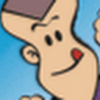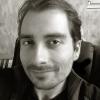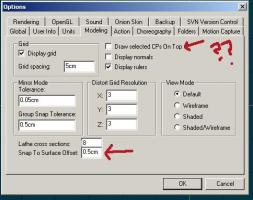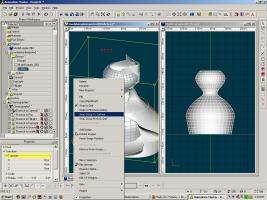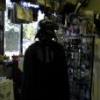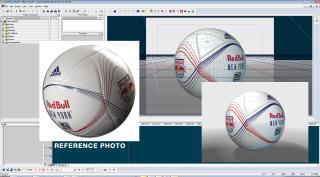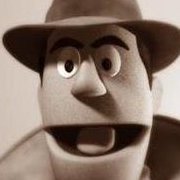Search the Community
Showing results for '"snap to surface"'.
-
Several areas I haven't yet fully explored: Templates to aid in modeling with Snap to Surface (Some will be more optimal than others) Mixing Props and A:M Models to further enhance workflow (What isn't caught by the Prop might be caught by the Model) -- The example of this would be a flat plane that is placed at a point of intersection with the Prop. Should a CP be placed off the Prop then it would be caught by the Model. Animated Snap to Surface (I need to learn to screen capture my tests because I've forgotten my earlier exploration into this area. The idea is to model on top of (or to track) a moving Snap to Surface object.) Further investigation into what Snap to Surface sees and what it allows through/ignores. (This relates to Templates in that a mesh could be built that would allow something akin to Snap to Intersection. Further exploration of the use of Snap to Surface in conjunction with other tools such as Snap to Grid, Magnet Mode etc. Theoretically, Snap to Surface in conjunction with Snap to Grid should result in a semblance of Snap to Intersection.
-
DJ added this to his report: Requested Tools: 1. Snap to intersection. (with a button instead of a key so you can turn it on and off) 2. Set "Y" key to snap to midpoint of line as in the model window. 3. Mouse right click and drag to select is not available and would be handy. 4. Distortions Box as in model window. My initial thought is to consider if these features already exist for Snap to Surface workflow within a Modeling window. This provides a framework from which to study and better understand the workflow with Props in the Chor window. The image DJ provided isn't exactly clear with regard to what he is after: Image Link But Fuchur helped determine what he was after: Fuchur asked: DJ responded: This appears to be a new feature request and not just an enhancement.
-
Reference: [bug]6102[/bug] I'm wanting to explore a few of the reports filed away in A:M Reports in order to better understand what the user was/is looking for and so that in v18 they will be more likely to see what they are looking for. Obviously my exploration will stop short of any coding or programming... but in the exploration who knows what might be found! Report 6102 looks like one worth exploring because it is likely the reporter hasn't yet fully explored the Snap to Feature tools in light of other tools currently available in A:M. General Data: 6102 DJBREIT moderate beta0 Modeling 3/26/2012 Windows 7 64-bit Sevice Pack 1 i7 960 3.20GHz Description: Some extra tool to round out the Snap to Surface This is a new and unassigned report. In the exploration I hope to learn more about what the current implementation of Snap to Surface can do. My focus has been within the Modeling window and with use of models/structures created in A:M but I am not averse to using imported Props. I am just more personally interested in a purely A:M-centric workflow.
-
Here is a quick test of Sweeper used in conjunction with v17's new Snap to Surface modeling feature. The vine's path was quickly drawn onto the column and then Sweeper followed that path up the column. (Minor movement of a few splines was done to adjust for passthroughs)
-
Pretty amazing stuff. As amazing as this is we can come pretty close to that stuff where they draw on top of the guys hand and it inbetweens the rest automatically with A:M's new 'Snap to Surface' feature. Of course there is a lot more going on than just the matching of animation lines to surfaces in 'Paperman'...
-
Using A:M's 'Snap to Grid' in conjunction with "Snap to Surface" will get this done and with a high degree of precision. Grids used with 'Snap to Grid' can be anywhere between .001cm and 10000cm if I am remembering correctly. Changing grid sizes on the fly while modeling is a great way to control precision placement of CPs. In this way, we can get two surfaces really close together without touching one another. Using A:M's 'Snap to Grid' in conjunction with "Snap to Surface" or any of a host of other modeling features will get this done and with a high degree of precision. Grids used with 'Snap to Grid' can be anywhere between .001cm and 10000cm if I am remembering correctly. Changing grid sizes on the fly while modeling is a great way to control precision placement of CPs. In this way, we can get two surfaces really close together without touching one another. Added: Grabbing a group of CPs and moving them doesn't conform to snap-to-grid and I'm not sure if this is by design or error. It seems to me that when 'Snap to Grid' is enabled everything should snap to the grid. There appears to be some tolerance issues in snapping to grid but I need to investigate. Moving with arrow keys always seems to snap the groups CPs to grid while moving with the mouse does not. Edit: It's primary scaling that breaks free of snap to grid. Perhaps the reason is that scaling and snapping to a grid would work against each other?
-
Looking good Mark! I foresee that in time you'll be cutting that 'few hours' down to a matter of minutes. I confess that I need to explore 'Snap to Surface' in the Chor. Up to this point I've mainly been using proxy shapes to guide the snapping to surface in the Modeling Window. Take a bunch of premade shapes and move them around to form a shape/character... lock them into position with the Lock tool... then spline all over the top of those while scrolling around in a 3D environment. Fast and fun! Your spline layout looks optimal.
-
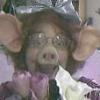
Transparent materials don't display transparent (v17)
NancyGormezano replied to pixelplucker's topic in Animation:Master
Hooo hooo! You guessed that right. I have figured out what I was doing wrong. Yay! It seems I did not have the little new "snap to surface" icon depressed BEFORE I started splining the new model (somehow I missed that crucial step in your video). When I did that - all became wonderful! The clouds parted and the birds began to sing. The problem I had been running into (and still) is that I would create some new patches close to the obj template model, then select those patches, right click (while patches were selected) and select "snap group to surface" option. Not a good idea. That is when things get weird. Some of the cps snap to a far surface, and some don't. It's not clear how to control that. But at least the original laying down of splines on top of a 3D obj template/prop seems to work better. It's the post-"snap group to surface" that works wonkily. -

Transparent materials don't display transparent (v17)
NancyGormezano replied to pixelplucker's topic in Animation:Master
My understanding is that Direct X is not the same as Direct3D. Does your card support Direct3D? I experience the same transparency problem with PROPS and transparency that you do, when trying to see the patches of A:M models thru the PROP. I have not tried Direct3D yet with 32 bit ver17. However I just don't get this retopo stuff...Whenever I select patches in the chor of the model I am trying to create using an .obj prop as a 3D template - and I select "snap to surface" - I invariably get CPs that jump to the wrong surface. Some are correct - others are wrong. I must be doing something wrong, or not understanding the process at all. -
Snap To Surface... this is one of the greatest new features... dont forget it! See you *Fuchur*
-
Ah Yes - true. I'm not finding I need anything denser So, for my purposes, I am finding that it is just simply easier to create a new spline model with both the chor and model windows open, and not necessarily always use the snap to surface tool. I would only use it when it helps, and primarily in chor. What I am finding easiest (and probably, maybe, the way others have been doing it before): 1) Start new chor. Delete everything. Drag/Import the 3D mesh that is to serve as a template into the blank chor (as a prop if .obj) or as a simple primitive model if created in A:M. 2) Start a new blank model, drag into chor. 3) Make the 3D template model unpickable in chor. Optionally make it a color, with transparency. Make it display either as shaded or shaded with wireframe. Make the new model display as wireframe (or whatever), different color. Select the blank model in chor. Go into modeling mode (F5). 4) Open the window for the new blank model. With both model window & chor window open (alt V), start laying down new splines in chor window and model window (thus having access to all tools), and observe in chor window how it conforms to the 3D template. If I want to use the snap to surface feature, then I do it in the chor window and simultaneously observe what's happening in model window.
-
Hey everyone. I'm considering trying to transfer a very dense figure model into A:M. I was hoping that the re-topo tool would help out, but I was not able to find much on what others had been able to get out of it. Has anyone been successful in "retopo'ing" a high dense mesh, human figure in A:M?? William
-
The video was great, thank you, thank you! And yes I was more successful with modeling and using S2S in the chor using an obj model as the template, based on what you demonstrated in your video. However, it seems like not all modeling functions are available - particularly "y" to add a cp to a selected spline, or to "drag selection" in the chor (must click on lasso first instead). So, I again tryed to model in modeling window with snap to surface (offset=.5 cm - the default) - I had an awful time trying to get the CP's to snap to the front surface - almost impossible (was not successful ever). It keeps snapping to the furthest surface - the projection of new CP's onto the surface seems weirdly wrong, regardless of any changes in offset value or if I have the option to "draw selected cps on top" checked or not. I also experienced crashes. Not sure what I did. How do you keep the new cps, or when moving the new cps, from snapping to the furthest (screen space) surface?
-
What you did wrong was this: In the chor, go to your PWS and click on your empty patch-model. Then click on the "Modeling-Mode" (F5). If you now click on the Add-button, you will create new CPs in the empty patch-model while being in the chor. That is the way that should be used for polygon-models as references. ///////////////////////////////////////////////////////////////////////////////////////////////////////////////////////////////// Snap-To-Surface is also very helpful for creating for example cloth for characters, etc. For that you can use Snap-To-Surface in the modelling-window. First model you character, then use Snap-To-Surfac ein the modelling-window too model cloth fitting the body. Info: Note that you can set a distance-value for the snap-to-surface-tool now (I think from beta 4 or 5 on). The Option for that can be found at "Tools > Options > Modelling > Snap to Surface Offset". Hope that helps a little. See you *Fuchur*
-
I am not understanding how to use the snap to surface feature? This is my first time trying it. Can someone walk me thru the steps to get started, please. I have made a SIMPLE obj in A:M (model exported as obj) I imported that obj 1) as a prop, and 2) imported that obj into a blank model. I have tried to use the snap to surface feature both in model window, as well as in chor (with prop) If I try to do it in the chor, and use the Add cp's - I get a path object If I try to create CP's in model that has prop imported in it (used plugin - import, obj) - I can't seem to control how the cps snap to surface. No comprendo. Que pasa?
-
Installers: http://www.hash.com/ftp/pub/updates/window...ta/AM_32BIT.exe (Windows 32bit) http://www.hash.com/ftp/pub/updates/window...ta/AM_64BIT.exe (Windows 64bit) http://www.hash.com/ftp/pub/updates/osx/v17_beta/AM.zip (Mac) Change All: Changed Log Rotoscopes empty rotoscopes are not longer loaded/saved rotoscopes for figures having also now their own folder (like camera/lights in the chor), but only when You create a new rotoscope, existing rotoscopes are displayed as before outside a rotoscope folder in a chor this folder is only displayed , when "Show more than drivers" for the model is active New All: [bug]6107[/bug] Snap-To-Surface: Offset-Value it's now possible to use a offset , when adding cp's and Snap To Surface is active the offset value can changed under Tools->Options->Modeling and is used when You hold down the Shift-Key while adding cp's the offset is added in the normal direction for the underlying object patch it work's in the same manner also for "Snap Group to Surface" Fixed All [bug]6119[/bug] particle system keys corrupted after reload of PRJ Fixed All [bug]6133[/bug] Refresh-Problem for fluid-particles in shaded mode Fixed All [bug]6131[/bug] Newton creates keyframes at 25 fps, not the PRJ fps setting Fixed All [bug]6132[/bug] CP weight editor displays incorrect values Fixed All[/b] [bug]6122[/bug] Composite doesn't free memory after each frame resulting in a rapid buildup of memory and hanging the computer Fixed All [bug]6124[/bug] NetRender "elapsed" column diplays strange numbers Fixed All [bug]6115[/bug] Invisable Particle Sprites in "Render Lock Mode" Fixed All [bug]6120[/bug] Closing PRJ during progressive render causes crash Fixed All [bug]6121[/bug] Translate manipulator appears as solid box in Bones Mode Fixed All[/b] [bug]6118[/bug] Refresh-Problem for some materials > Results in a Crash Fixed All [bug]6113[/bug] Rotate manipulator not visible when editing Distortion Box CPs Fixed All [bug]6112[/bug] Editing Distortion Box causes crash Fixed All[/b] [bug]6114[/bug] Dragging CPs in model window causes crash Fixed All [bug]6117[/bug] "selected" tab doesn't wok in Actions
-
Something you'll love in v17 is the Spline to Surface tool. With it you can model on top of an existing construct and even change/replace that underlying construct too. It's also great for modeling extra (unconnected) details right on top of a model. Note to those using Spline to Surface in a Modeling Window: I find it best to lock down the template after drawing a small 2 CP spline using the Lock key/icon. Then delete that spline and model over the locked geometry. Of course... make sure you select the Spline to Surface icon before splining or else you'll model a lot of geometry that isn't on the intended surface. Doh! I hate it when I do that. Snap to Surface, not Spline to Surface Rodney, but other than that: Yes, good suggestions. See you *Fuchur*
-
Hi guys, just a short info on the new features of A:M v17: Snap to Surface (see more informations here) This is a new feature, which gives you the abillity to model around other models. This can be used with polygon-models / props and with patch-models. It is very useful in several ways (these are only the once I can think of right now): "Import" even complex polygon-models into A:M: You can import props with many many polygones and remodel them very easily with patches. For other 3d programs this is called "Retopology", so in other programs remodelling is done with polygones too. So we can call it "Retopology+" Create cloth for your characters: You can model for example a t-shirt very easily on top of your character. If you are done, use the PushCP-Plugin to enlarge the t-shirt a little and you are ready to go. Use it as a modeling-tool Use primitive objects (spheres, cubes, etc.) to define a basic shape. After that use Resurface to model "around" those primitive objects. It is a little bit like metaballs done by hand > "Manual MetaBalls". Animation:Master Answers A:M Answers is a feature, which will help you to access informations about certain features in a very easy way. To activate it, right-click on any property in the PWS and choose "Display help informations". A new window will be opened with informations about this property. Now you can just click on other properties to get the corresponding informations in the help-window. These informations can easily be altered, a link to for example a tutorial or a video can be given and it can be shared with others by using the built-in A:M-Answers Editor. SSE4 For newer processors, which are compatible with SSE4, A:Ms rendering will be up to 15% faster. Create your own "Support"-page Now A:M lets you create a html-file which will be shown in the community-window. It is editable by the user and you can place any content there you want. One example for that can be found as an attachment to this post. Copy this file into your A:M installation-folder, (re)start A:M and open your community-window. What you can do with it? For example: Have a place to store all the most needed tutorials in A:M to be accessable from A:M with only one click or to use it for inspiration or whatever you want. Share your creations with us here on the forums! Of course there are many bug-fixes and smaller advantages. (for example: There is now an indication-border if you have the Animate-Mode deactivated, etc.) Have fun testing these new features! Hopefully you find them as helpful as I do! See you and happy splining! *Fuchur* Support.html ama_userguide.mp4
-
Yes, the models have bodies, also decaled and textured. Though, I won't show them til I have some time to model some clothing for them (don't think it's appropriate to show on the forum). I was hoping v17 will be out soon, so I can use the new feature "Snap to Surface" tool. And I have to start experimenting with simcloth.
-
Hey - I took a chance to do a job today with the new 'Snap To Surface' tool, and it saved the day! Don't know how I woulda done this without it. Shawn Rogers asked if I could model this 'NEWFANGLED' soccer ball(ref photo) for him... at first I though- NO WAY, but then figured the S2S tool may help in the process and it could be a good test for it. Plus I love the challenge, the ball looks SO simple, yet it is really QUITE a modeling dilemma. 1st- I lathed a really dense sphere and exported it as an OBJ. Then imported it into the chor as a prop... this was to be the surface for me to draw on, activating the S2S function. A couple false starts, a couple rounds of 'make it bigger-make it smaller' and I had a good workable base. The tool and the 'snap group to surface' option worked really well, a couple of times it would snap to the backside surface- but the undo got me back. Whats REALLY nice is when you have the tool ON, you can slide CPs around and they adhere perfectly to the surface. I will post a 360o render when it finishes. The Snap To Surface tool will be available in Version 17.
-
I'm envisioning a new color, similar to the new red for non-animate mode. Maybe green for Snap to Surface mode?
-
Just an advisory note: you'll want to make sure you turn off snap to surface when you are finished. It causes all-new kinds of unexpected behavior in the modeling window when it's left on. Inadvertently leaving snap to surface and mirror mode on might even tear a hole in the space-time continuum. :-)
-
I'm glad I read this because I was surely going to keep confusing everyone by calling it the Retopology tool. Snap to Surface works for me.
-
Yeah, to reiterate Fuchur, the tool is simply called Snap-to-Surface- probably a wise move by our Yoda. WE are the ones who have monickered it as Retopology... we should probably thus start referring to it in it's proper context. OR, how about this... wait....... wait for it........... S2S !!! I have to say that it was me who called it "Retopology-Tool" for the first time. Sorry about that. The feature-request for it initiated the "Snap to Surface"-button so. Anyway to let people know what it is about more or less it is easy to say "Retopology". In the end it is retopology + X so. I don't think that it is too bad to call it retopology-tool so... what does it harm? But okay, lets call it "Snap-To-Surface"-Tool from now on. See you *Fuchur*
-
As a for instance... one thing I've noted is that we can model with changing surfaces over time. Are you saying we can load morph targets too? Just simply swap out the target mesh with another and move the time slider over, re-snap the cp's to the new surface? Something like that? That would be pretty cool. A:M can not import Morph targets as far as I know. But yes it really doesnt matter what you want to retopologize. It even does not have to be one object. You can draw over several objects at once if you wish too, or you can change the template-object in the process to another one or you can move / rotate / scale the template-object while doing your snap to surface work, etc. You can although use Snapt to surface-option for animation... so for example if you created a model and want to animate the CPs you can use Snap To Surface in the Muscle-Mode in the Chor too to change its shape... So you could recreated the morph-targets from other programs easily by recreating the model in A:M with resurface, export another prop from the other software which has the shape of another morph-target and use it to create another keyframe in A:M's chor which will have the same shape as the morph-target in the other program. That will enable you to copy the CP-movement to a pose and like that you have a translation of a morph-target to A:Ms poses... The real feature is: Snap a point to an underlying surface, no matter if it is a prop, another patch-model, a combination of both or several of them... See you *Fuchur*
